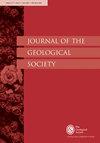白云岩在半同期次生成岩过程中形成:巴西 Brejo do Espinho 泻湖中形成的现代白云岩结壳的证据
IF 3
3区 地球科学
Q2 GEOSCIENCES, MULTIDISCIPLINARY
引用次数: 0
摘要
有人提出,在半干旱条件下,亚生代暴露阶段碳酸盐泥的早期岩化可促进白云岩的形成。然而,亚生成岩过程中的生物地球化学过程如何促进白云岩的形成仍不清楚。在此,我们采用多代理方法,通过分析在环礁湖 Brejo do Espinho(LBE)形成的现代白云石结壳,研究白云石的形成过程。岩石学分析表明,结壳由高镁方解石(HMC)和白云石共存组成。铁和锰的浓度较低,表明白云石是在缺氧条件下形成的,而钙锶浓度较高的结壳则表明是由细菌诱导的原生白云石沉淀。与现代sabkha白云岩相比,结壳的镁同位素组成显示出较轻的值,表明白云岩化过程和镁来源不同。结壳的δ ¹³C 负值比 LBE 中未碎石的碳酸盐泥更大,表明 13 C 贫化有机碳的加入。在次生成岩过程中,与有机质衰变有关的生物地球化学过程会产生部分氧化的有机质,从而促进 Mg 2+ 的脱水,并增强原生 HMC 的溶解,最终引发 HMC 向白云岩的转变或/和白云岩的直接沉淀。古代 "白云石工厂 "通过碳酸盐沉积物的循环沉积和半同期次生成岩作用而运行。 专题文集:本文是 "走向解开'白云石问题':新方法和新视角 "专题集的一部分,可在以下网址查阅:https://www.lyellcollection.org/topic/collections/towards-unravelling-the-dolomite-problem。本文章由计算机程序翻译,如有差异,请以英文原文为准。
Dolomite formation during penecontemporaneous subaerial diagenesis: Evidence from modern dolomite crusts forming in lagoon Brejo do Espinho, Brazil
Early lithification of carbonate mud during the subaerial exposure stage, under semiarid conditions, has been proposed to facilitate dolomite formation. However, how the biogeochemical processes during subaerial diagenesis promote dolomite formation remains unclear. Here, we employ a multiproxy approach to investigate the process of dolomite formation by analyzing modern dolomite crusts forming in lagoon Brejo do Espinho (LBE). Petrological analysis reveals that the crusts comprise coexisting high-Mg calcite (HMC) and dolomite. Low Fe and Mn concentrations indicate the formation of dolomite under oxic conditions, while a higher Sr concentration in well-lithified crust suggests primary bacterial-induced dolomite precipitation. The Mg isotopic composition of the crusts exhibits a lighter value compared to that of modern sabkha dolomite, suggesting different dolomitization processes and Mg sources. More negative
δ
¹³C values of the crusts than unlithified carbonate mud in LBE, indicating the incorporation of
13
C depleted organic carbon. The biogeochemical processes related to decaying organic matter during subaerial diagenesis generate partially oxidized organic matter that promotes Mg
2+
dehydration and enhances the dissolution of primary HMC, ultimately triggering the transition of HMC to dolomite or/and direct dolomite precipitation. The ancient "dolomite factory" operated through cyclic deposition of carbonate sediments and penecontemporaneous subaerial diagenesis.
Thematic collection:
This article is part of the Towards unravelling the ‘Dolomite Problem’: new approaches and novel perspectives collection available at:
https://www.lyellcollection.org/topic/collections/towards-unravelling-the-dolomite-problem
求助全文
通过发布文献求助,成功后即可免费获取论文全文。
去求助
来源期刊

Journal of the Geological Society
地学-地球科学综合
CiteScore
6.00
自引率
3.70%
发文量
68
审稿时长
6-12 weeks
期刊介绍:
Journal of the Geological Society (JGS) is owned and published by the Geological Society of London.
JGS publishes topical, high-quality recent research across the full range of Earth Sciences. Papers are interdisciplinary in nature and emphasize the development of an understanding of fundamental geological processes. Broad interest articles that refer to regional studies, but which extend beyond their geographical context are also welcomed.
Each year JGS presents the ‘JGS Early Career Award'' for papers published in the journal, which rewards the writing of well-written, exciting papers from early career geologists.
The journal publishes research and invited review articles, discussion papers and thematic sets.
 求助内容:
求助内容: 应助结果提醒方式:
应助结果提醒方式:


